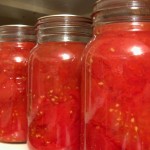
Whether you are new to canning, returning to canning because of the pandemic, or have always canned the bounty of your harvest, there are certain tips that will help ensure that your time and efforts lead to safe, healthy food for your family.
Use recipes that are up to date. Some canning recommendations have changed dramatically over the last 20 years. While capturing a family-favorite memory might be your goal, recipes from cookbooks and the internet are generally not tested to ensure safety. Especially if you are using recipes that date before 2015, it’s a good idea to compare your home recipe with research-tested recipes, choosing a tested recipe to ensure your efforts are safe and delicious. The good news is that all research-tested recipes are available for free from the National Center for Home Food Preservation. Recipes for canning vegetables or tomatoes, fruits, meats or even fermenting sauerkraut or making genuine crock pickles are all available.
Start with equipment in good working order. This canning season, some equipment has been in short supply. Some canners are hard to find and jars and lids have been scarce. The right equipment is still important! Remember that some pots can double as a boiling water canner. A boiling water canner should have a flat bottom so that it fits nicely on the stove top, and a tight-fitting lid. An alternative to a boiling water canner for acidic fruit or pickles is to use an atmospheric steam canner. A steam canner uses non-pressurized steam to safely can high-acid foods. If you are canning low-acid foods like vegetables or meats, you must use a pressure canner. A pressure canner will have either a dial-gauge or a weighted gauge. A tested recipe will give instructions for using a pressure canner to safely preserve food. A multicooker such as an Instapot is not safe for home canning. Review information on safely using a boiling water canner, and atmospheric steam canner, or a pressure canner before you begin.
Assemble jars and other items. Extension recommends standard home canning jars (Mason-style jars) for canning. If you choose to use other types of jars, they must fit a two-piece metal lid and band. There is greater risk of jar breakage and possible seal failure with non-standard canning jars. Check all jars to make sure they are not chipped or cracked. Only two- piece lids are recommended for home canning. For best performance, lids should be purchased new each year (the sealing compound will break down on storage); although stored in a cool, dry location, lids stored up to three years may seal. Under no circumstances should you reuse canning lids. A jar that does not seal effectively may spoil or the contents may become unsafe. Individuals who have been canning for years are often surprised to find that lids no longer need to be heated before use, and they should never be boiled before using. Both jars and lids should be washed in clean, soapy water and rinsed before use. Jars should be pre-heated before filling. Sort through screw bands to make sure they are not rusted before applying. Other items that come in handy for home canning include jar fillers, tongs, and lid wands.
Home canned items should be stored in a cool, dry location. After cooling and jars have sealed, remove screw bands and gently wash jars and bands in soapy water, rinse, and dry. Washing will remove any food residues that may support mold growth on storage. Store canned items with the screw bands removed; this makes it easier to see when jars become unsealed. Home canned food is best consumed within one year. Food preserved using a research-tested recipe should retain high quality for up to three years if stored in a cool location.
What if you can’t find supplies? Some canning supplies are in short supply. Consumers have had trouble finding jars and lids, and canners have even been sold out. For safety sake, consider these options:
- Freezing. Some items that would normally be canned may be successfully frozen, this is particularly true of salsas and tomato products. Prepare as directed, package in freezer containers, and freeze. While vegetables may be prepared differently for canning and freezing, home-frozen vegetables are a delicious addition to a family meal. Meat is another item that freezes well. Instructions for preparing foods for the freezer can be found on the National Center website or the Wisconsin safe preserving website. The Wisconsin bulletin Homemade Pickles and Relishes has information on making delicious freezer pickles!
- Refrigeration. Holding foods in the refrigerator will extend the shelf life for several weeks, allows flexibility in the containers that you use, and may be an option for items that can not be safely canned. Prepare your family-favorite recipe, whether a salsa or soup, and store in the refrigerator for up to two weeks; if meat is added, limit store time in the refrigerator to one week. Pickle recipes designed to last a bit longer in the refrigerator can be found in Homemade Pickles and Relishes.
- Drying. Fruits and vegetables can often be safely dried in an oven or dehydrator at home. Instructions for drying fruits and vegetables at home with excellent results are available form the National Center for Home Food Preservation.
The publication Food Storage for Quality and Safety includes tips on handling and packaging that will help ensure that the foods that you preserve will be the best quality possible when you use them.
Overall, be sure to make food-safe choices so that your pantry and freezer supplies your family with safe and healthy foods year round.
Subscribe to the blog to receive food safety and food preserving updates.




